
Xanthidae is a family of crabs known as gorilla crabs, mud crabs, pebble crabs or rubble crabs. Xanthid crabs are often brightly coloured and are highly poisonous, containing toxins which are not destroyed by cooking and for which no antidote is known. The toxins are similar to the tetrodotoxin and saxitoxin produced by puffer fish, and may be produced by bacteria in the genus Vibrio living in symbiosis with the crabs, mostly V. alginolyticus and V. parahaemolyticus.

Pinnotheres is a genus of crabs, including the pea crab. Many species formerly in Pinnotheres have been placed in new genera, such as Zaops ostreus, the oyster crab and Nepinnotheres novaezelandiae, the New Zealand pea crab. The species currently recognised in the genus Pinnotheres are:

Portunidae is a family of crabs which contains the swimming crabs. Its members include many well-known shoreline crabs, such as the blue crab and velvet crab. Two genera in the family are contrastingly named Scylla and Charybdis; the former contains the economically important species black crab and Scylla paramamosain.
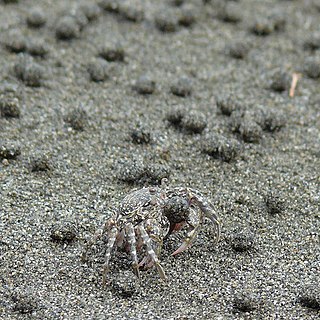
Sand bubbler crabs are crabs of the genera Scopimera and Dotilla in the family Dotillidae. They are small crabs that live on sandy beaches in the tropical Indo-Pacific. They feed by filtering sand through their mouthparts, leaving behind balls of sand that are disintegrated by the incoming high tide.
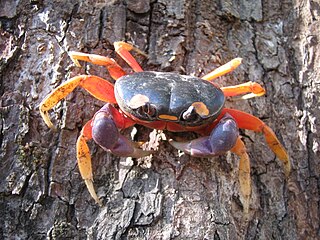
Gecarcinus is the type genus of the land crab family Gecarcinidae. They are found in warmer coastal regions of the Americas, including islands in the Caribbean. Four species from oceanic islands were formerly included in Gecarcinus as the subgenus Johngarthia, but are now treated as a separate genus, Johngarthia. While all members of this genus are largely terrestrial, they have to return to the ocean to breed. They are often colourful, with reddish, orange, purple, yellowish, whitish, or blackish being the dominating hues. This has resulted in some species, notably G. quadratus and G. lateralis, gaining a level of popularity in the pet trade.

The Varunidae are a family of thoracotrematan crabs. The delimitation of this family, part of the taxonomically confusing Grapsoidea, is undergoing revision. For a long time, they were placed at the rank of subfamily in the Grapsidae, but they appear to be closest to Macropthalmus and the Mictyridae, which are usually placed in the Ocypodoidea. It may thus be better to merge the latter superfamily with the Grapsoidea, retaining the latter name as it is older.

Liocarcinus holsatus, sometimes known by the common name flying crab, is a species of swimming crab found chiefly in the North Sea, Irish Sea and English Channel. It has a carapace up to 4 centimetres (1.6 in) wide, which is brownish-grey with a green tinge. It is very similar in appearance to the harbour crab Liocarcinus depurator.

Pilumnoidea is a superfamily of crabs, whose members were previously included in the Xanthoidea. The three families are unified by the free articulation of all the segments of the male crab's abdomen and by the form of the gonopods. The earliest fossils assigned to this group are of Eocene age.

Actumnus is a genus of crabs in the family Pilumnidae. Alongside the 28 extant species, it has a fossil record extending back into the Miocene.

Hemigrapsus is a genus of varunid crabs comprising thirteen species native almost exclusively in the Pacific Ocean, but two have been introduced to the North Atlantic region.

The family Homolidae, known as carrier crabs or porter crabs, contains 14 genera of marine crabs. They mostly live on the continental slope and continental shelf, and are rarely encountered. Members of the Homolidae have their fifth pereiopods in a sub-dorsal position, which allows them to hold objects in place over the rear half of the carapace. The objects carried include sponges, black corals and gorgonians, and this behaviour may be a defence mechanism against predators. Some species have been observed carrying living sea urchins in a symbiotic relationship which allows them to benefit from the protection of the urchin's dangerous spikes.

Dyspanopeus sayi is a species of mud crab that is native to the Atlantic coast of North America. It has also become established outside its native range, living in Swansea Docks since 1960, the Mediterranean Sea since the 1970s, the North Sea since 2007 and the Black Sea since 2010. It can reach a carapace width of 20 mm (0.8 in), and has black tips to its unequal claws. It feeds on bivalves and barnacles, and is in turn eaten by predators including the Atlantic blue crab, Callinectes sapidus. Eggs are produced from spring to autumn, the offspring reach sexual maturity the following summer, and individuals can live for up to two years. The closest relative of D. sayi is D. texanus, which lives in the Gulf of Mexico; the two species differ in subtle features of the genitalia and the last pair of walking legs.

Hyastenus is a genus of crabs in the family Epialtidae, subfamily Pisinae, containing the following extant species:
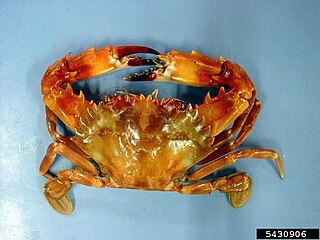
Charybdis hellerii, the Indo-Pacific swimming crab or spiny hands is a species of crab from the swimming crab family, the Portunidae. Its native range covers the Indian and Pacific Oceans but it has been introduced to the western Atlantic and has invaded the Mediterranean. It is a commercially exploited species in south-east Asia.
Charybdis longicollis, the lesser swimming crab, is a species of crab from the swimming crab family, the Portunidae. It has a native range which covers the north-western Indian Ocean and it has invaded the Mediterranean Sea by Lessepsian migration through the Suez Canal.
Jentina E. Leene was a Dutch scientist who had an early career in zoology, specifically carcinology, was a science teacher and then a textile scientist. Her zoological work was highly regarded, especially her doctoral thesis on the swimming crabs of the genus Charybdis.
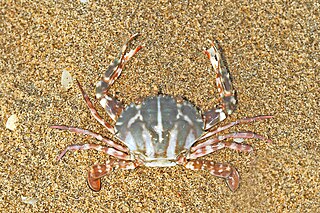
Charybdis feriata, the crucifix crab, is a species of swimming crab in the family Portunidae. It is found in the tropical and subtropical Indo-Pacific region.

Austruca is a genus of indo-west Pacific fiddler crabs in the family Ocypodidae. There are about 13 described species in this genus.
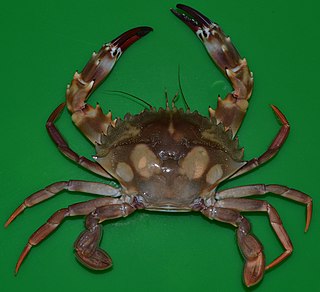
Charybdis lucifer, also known as the yellowish-brown crab, is a species of swimming crab in the family Portunidae.


















